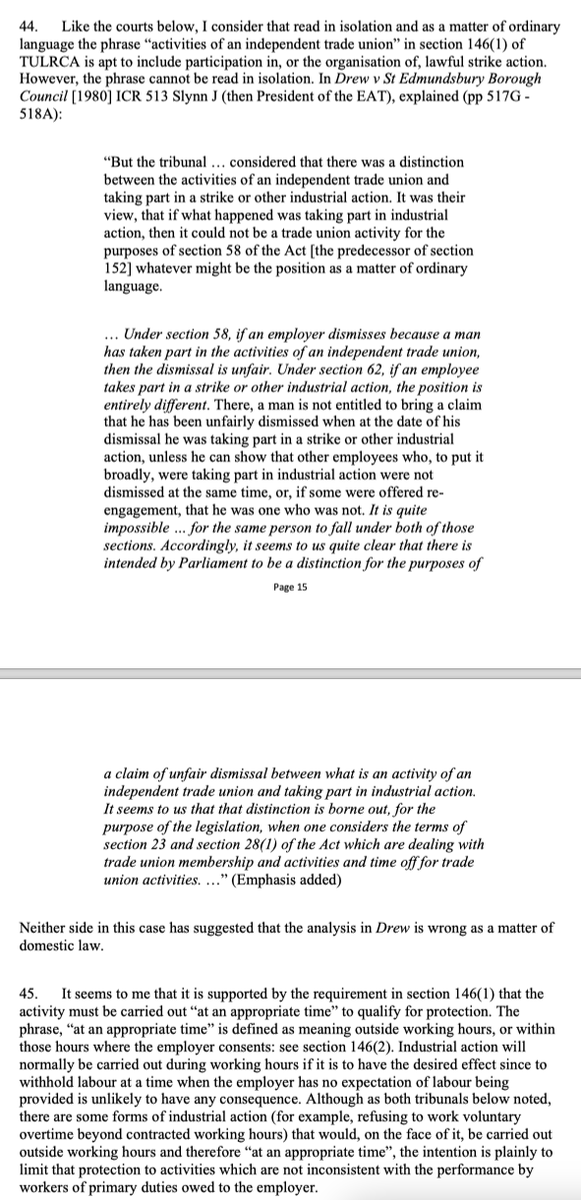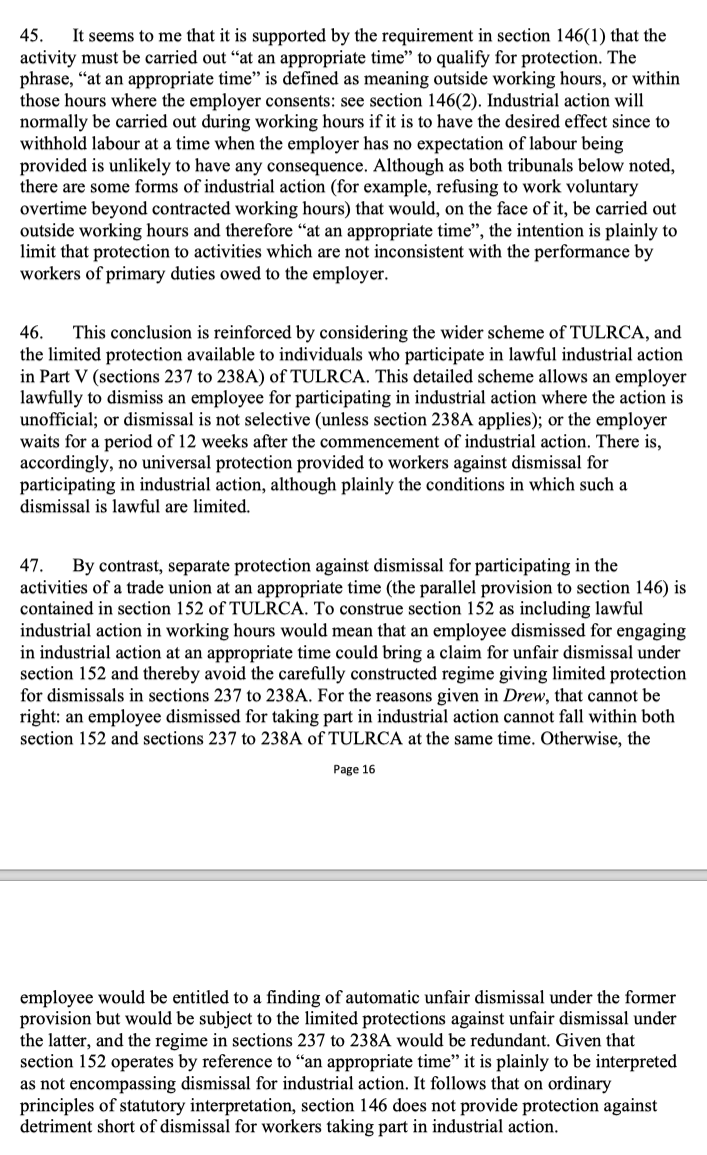🧵SSBT v Mercer: Supreme Court issues declaration of incompatibility re the lack of protection from sanction short of dismissal for workers taking part in strike action. The current position breaches Art 11 ECHR.
#ukemplawsupremecourt.uk/cases/docs/uks…
#ukemplawsupremecourt.uk/cases/docs/uks…
2/ M was a support worker in the care sector & a UNISON workplace rep, who planned & participated in a lawful strike at her workplace. She was suspended, receiving normal pay but no overtime. Suspension removed her from the workplace during the period of industrial action.
3/ M was also given a first written warning, though that was overturned on appeal.
M brought an ET claim reliant on s.146 TULR(C)A, which provides protection against detriments for taking part in trade union activities. The statutory provisions are below:
M brought an ET claim reliant on s.146 TULR(C)A, which provides protection against detriments for taking part in trade union activities. The statutory provisions are below:

4/ The words "at an appropriate time" in s.146(1)(b) is defined by subsection (2) to exclude working time (save with employer consent) & thus to limit protection to activities outside working time & hence not to apply to strikes which take place very much within working time.
5/ The question going through the courts from ET to Supreme Court were concerned with (i) whether this lack of protection breached Art 11 ECHR & (ii) if yes, whether s.146 could be interpreted consistently with Art 11, whether under s.3 Human Rights Act or otherwise.
6/ The EAT arrived at a compatible construction by adding to s.146(2): "(c) a time within working hours when he is taking part in industrial action". At the CA it was recognised this went too far & would protect unlawful strikes, so M proposed it be rewritten as below: 

7/ The CA held s.146 was incompatible with Art 11, s.3 HRA couldn't stretch far enough to allow a consistent interpretation without amounting to judicial legislation, but that a declaration of incompatibility couldn't apply to a gap in the law rather than incompatible provision.
8/ The Sup Ct noted a number of TULRCA provisions including the s.152 protection for employees from dismissal for TU activities. Part V provisions on strike action & when the union has immunity from suit, & when unfair dismissal can be claimed for taking part in industrial action 

9/ M's case at the Supreme Ct was that the ECtHR consistently held A11 to protect TU members subject to sanctions (no matter how small) which were intended to deter them from, or penalise for, taking part in lawful industrial union action.
10/ In seeking to persuade the Sup Ct to construe s.146 compatibly, M argued the thrust of TULRCA is that lawful strike action is legit & s.146 is there to protect freedom of association, & that the separate unfair dismissal provisions didn't bar a compliant s.146 construction. 

11/ M sought to persuade the Sup Ct that the additional words proposed as s.146(2)(c) in the CA was appropriate. If not, that the CA erred in declining to make a declaration of incompatibility. 

12/ The SoS argued A11 didn't require universal protection to workers re detriment for taking lawful industrial action save where there was direct state interference or the employer was a state body. He argued s.146 was compatible with A11. If not the HRA couldn't help here. 

13/ The Sup Ct noted that whilst s.146(1) was apt to include participating in lawful strike action, it couldn't be read in isolation, & couldn't be read that way in light of the "at an appropriate time" wording & the wider TULRCA provisions on dismissal for striking. 

14/ In particular if s.146 included lawful strike action, so did the protection from dismissal under s.152, which would mean TULRCA had 2 sets of internally incompatible provisions on protection from dismissal for taking part in a strike, given ss.237-238A. That made no sense. 

15/ Lady Simler went through the legislative history of the protections for trade union activities & found a consistent inclusion of "at an appropriate time" which excluded activities during working hours. The history reinforced the limitations in what is now s.146. 

16/ Re A11, M recognised that it didn't extend to withholding of pay when striking but asserted all other detriments deterring or penalising from participation were in breach.
17/ The Sup Ct noted the ECtHR declined to hold that the right to strike an essential element of TU freedom, a finding which meant a lesser margin of appreciation didn't apply.
M responded by distinguishing between core & essential but Simler held them interchangeable.



M responded by distinguishing between core & essential but Simler held them interchangeable.



18/ The Sup Ct considered there was a wider margin of appreciation to the state as regulator as compared to when it was public sector employer. It couldn't be said that protection for striking workers was absolute & that detriment short of dismissal could never be justified.




19/ The A11 question was thus whether a fair balance had been struck. The Sup Ct found it hadn't. TULRCA provided no protection against ANY detriments short of dismissal to those striking. It was at least arguable extreme sanctions breached A11 (e.g. suing for loss of profit). 

20/ The right to take lawful strike action would dissolve if employees thereby exposed themselves to any detriment short of dismissal no matter how severe.
Legislation addressing action short of dismissal might've struck a fair balance, but no protection at all clearly didn't.
Legislation addressing action short of dismissal might've struck a fair balance, but no protection at all clearly didn't.

21/ Whilst s.146 was inconsistent with A11, alas the interpretive power under s.3 HRA, whilst powerful, didn't extend far enough, resisting M's efforts to persuade the court otherwise.
22/ The Court was concerned (a) as to how far protection should go given that not every detriment might breach A11; & (b) that reading in the proposed words would go against the legislative scheme, as it'd render inconsistency in dismissing employees & limb (b) workers.




23/ Turning to declarations of incompatibility, the court recognised the need for an identifiable provision of primary legislation which was incompatible with the ECHR. The Ct found, hesitatingly, s.146 legitimised sanction short of dismissal for lawful strikes in breach of A11. 

24/ The effect of s.146 was to block M's means of redress by way of a domestic claim for breach of A11 ECHR in re detriments short of dismissal for participating in lawful strike action & thus the CA's lacuna exception to declarations wasn't applicable.
The declaration was made


The declaration was made


25/ It's abundantly clear from the judgment that M's lawyers had to do a huge amount of persuasive spadework to get over the line. Kudos to @MichaelFordQC @SBrittendenKC @thebigbogg @Adam_Creme @ShanthaDavid & Bruce Robin for this victory.
@MichaelFordQC @SBrittendenKC @thebigbogg @Adam_Creme @ShanthaDavid It's now over to Parliament to work out whether to amend the legislation and how extensively to do so, otherwise it'll be off to Strasbourg for Ms Mercer.
• • •
Missing some Tweet in this thread? You can try to
force a refresh







